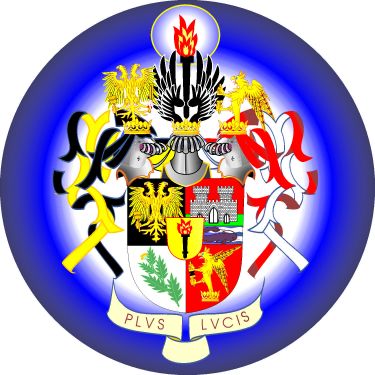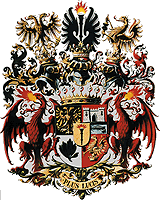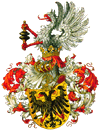

Carl Freiherr Auer von Welsbach (1858-1929)
[ discovered Praseodymium (Z=59) and Neodymium (Z=60) in 1885 ]
The following German blazon
[with a canting second quarter] is from the
book
"Österreichische Wappenkunde" (Austrian Heraldry) by Franz Gall.
It was kindly provided, and tentatively translated, by Jochen Wilke
who also presented us with the above depiction, on 2004-06-19.
[ © 2004
Jochen Wilke. This
copyrighted image is
reproduced here by permission. ]
The obscure picture
we had used prior to June 2004 shows
additional features, including two dragons Gules as supporters.
Geviert mit Herzschild:
1. in Schwarz ein rotbezungter goldener
Doppeladler,
in der rechten Klaue einen
goldenen
Winkelhaken,
in der linken ein
goldenes
Tenakel mit
Divisorium
haltend
(Buchdruckerwappen
mit
gewechselten Farben);
| |
Quarterly with an inescutcheon,
1. Sable, a double-headed eagle Or,
langued Gules,
holding in the dexter claw
a
composing
stick Or, and in the sinister claw
a
galley
with a copy holder
of the same
(arms of book printers,
with changed tinctures);
|
2 in Rot auf grünem Boden eine silberne
Zinnenburg mit
spitzgewölbtem
Tor und
zwei Seitentüren (aus dem Wappen der
Stadt Wels),
davor ein fließender Bach mit
natürlichem Wels;
|
2. Gules, upon a terrace Vert, a castle double
towered Argent
with a gothic archway
(from the arms of the city of Wels);
in a foreground creek, a catfish
Proper;
[ In German:
Wels = catfish,
Bach = creek ]
|
3 in Silber fünf gezackte, grüne Blätter
an einem Stiel
(Pflanze: Mithridat);
|
3. Argent, five serrated leaves
on a
stalk Vert (mithridate mustard);
|
4 in Rot ein aus einer goldenen
Blätterkrone wachsender
rotbezungter
goldener Greif,
zwei schwarzgepolsterte
goldene
Buchdruckerballen
gegeneinander pressend
( = Helmzier des Buchdruckerwappens).
|
4. Gules, a demi griffin Or langued Gules
issuant
out of a ducal coronet Or,
pressing together two
inking balls
of
the same, cushioned Sable.
(= crest of book printers)
|
Herzschild: in Gold pfahlweise eine
brennende schwarze Fackel.
|
Inescutcheon: Or, a torch Sable,
allumed Proper.
|
Drei Helme:
1 der Adler aus Feld 1;
2 die Fackel des Herzschildes zwischen
offenem schwarzen Flug;
3 der Greif aus Feld 4 wachsend.
Helmdecken: rechts Schwarz und Gold,
links Rot und Silber.
|
Three helms:
Dexter: The eagle of the first quarter.
Middle: Between two eagles wings Sable,
the torch of the inescutcheon.
Sinister: The griffin of the fourth quarter.
Mantling: Per pale, Sable doubled Or
and Gules doubled Argent.
|
|
Devise: Plus lucis.
|
Motto: Plus Lucis (more light).
|
Carl Auer was born in
Vienna on 1858-09-01
to Therese and Alois Auer. His father
Alois (1813-1869)
was an inventor and botanical illustrator who became director of the
Austrian State Printing House and was ennobled in 1860
(two years after the birth of Carl) with the hereditary title of
Ritter von Welsbach (Knight of Welsbach).
Carl was educated in the
Mariahilf and
Josefstadt central districts of Vienna.
After graduation, he joined the Austro-Hungarian Army and was commissioned as a Second Lieutenant (1877).
In 1878, he entered the University of Vienna
where he studied mathematics, general chemistry, thermodynamics, engineering and physics.
In 1880, he transferred to the University of Heidelberg
where he obtained his doctorate in chemistry (1882) under the direction of
Robert Bunsen (1811-1899;
PhD 1830)
inventor of the Bunsen burner (1855).
Auer would become rich and famous as a chemist, polymath, inventor,
entrepreneur and businessman. One of Austria's best.
The accomplishments of Dr. Carl Baron Auer von Welsbach include:
He received the
Siemens Ring in 1920 and
was the first recipient of the
Wilhelm Exner Medal (1921).
Carl Auer von Welsbach died on 1929-08-04 (at age 72) in
Rastenfeld
Castle the private residence he had aquired in 1893 at
Mölbling.
One of his direct descendents is Christoph Auer von Welsbach
(ChAvW).





